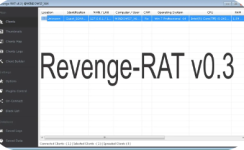FinlayCarrick07
Registered

What is Revenge-RAT v0.3 Cracked?
Revenge-RAT v0.3 is a Windows-based RAT designed to give attackers complete backdoor access to compromised machines. The cracked version removes license verification, allowing unrestricted use for malicious purposes. Once installed, it can:- Steal sensitive data (passwords, documents, cryptocurrency wallets)
- Log keystrokes & capture screens
- Execute remote commands
- Spread laterally across networks
- Download additional malware
Detailed Features of Revenge-RAT v0.3 Cracked
1. Remote System Control
- Live Desktop Viewing – Streams the victim’s screen in real time.
- Remote Shell Access – Executes commands via cmd/PowerShell.
- File Manager – Uploads, downloads, or deletes files remotely.
- Process Manipulation – Kills or spawns processes for persistence.
2. Surveillance & Data Theft
- Keylogging – Records all typed keystrokes (logins, messages, etc.).
- Clipboard Monitoring – Captures copied text (e.g., crypto addresses).
- Webcam & Mic Access – Secretly activates hardware for spying.
- Browser Password Extraction – Steals saved credentials from Chrome, Firefox, and Edge.
3. Persistence & Evasion
- Registry Modification – Ensures auto-startup via Run keys.
- Process Injection – Hides in legitimate processes (e.g., explorer.exe).
- Antivirus Bypass – Disables Windows Defender via PowerShell.
- Rootkit-like Hiding – Conceals files, processes, and network activity.
4. Network Propagation
- LAN/WAN Scanning – Detects other vulnerable devices.
- Brute-Force Attacks – Spreads via RDP, FTP, or SMB exploits.
- Worm-like Capabilities – Infects USB drives for physical spread.
5. Additional Malware Deployment
- Cryptominer Injection – Secretly mines cryptocurrency.
- Ransomware Payloads – Locks files for extortion.
- Botnet Recruitment – Enlists devices for DDoS attacks.
6. Customisation & C2 Communication
- Configurable Builds – Attackers customise features pre-infection.
- Encrypted C2 Traffic – Avoids detection by network monitors.
- Dynamic DNS Support – Uses changing domains to evade blacklisting.






